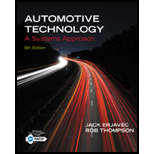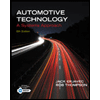
Automotive Technology: A Systems Approach (MindTap Course List)
6th Edition
ISBN: 9781133612315
Author: Jack Erjavec, Rob Thompson
Publisher: Cengage Learning
expand_more
expand_more
format_list_bulleted
Concept explainers
Textbook Question
Chapter 12, Problem 1ASRQ
While discussing the reasons for resurfacing a cylinder head; Technician A says it should be resurfaced to make it flat and very smooth so the head gasket can seal properly during engine assembly. Technician B says that it can be resurfaced to raise the compression. Who is correct?
- Technician A
Expert Solution & Answer
Want to see the full answer?
Check out a sample textbook solution
Students have asked these similar questions
Why is it important to loosen the cylinder head bolts in the recommended order?
Carbon deposits on the intake valve or seat may cause the valve not to close properly. Tech a says that the flywheel will be harder to spin when starting the engine. Tech b says that the engine will loose power. Who is correct?
Technician A says that a cylinder wall with too smootha surface will prevent the piston rings from seatingproperly. Technician B says that a cylinder wall shouldhave a crosshatch honing pattern. Who is correct?a. Technician Ab. Technician Bc. Both A and Bd. Neither A nor B
Chapter 12 Solutions
Automotive Technology: A Systems Approach (MindTap Course List)
Ch. 12 - Explain staged and continuously variable value...Ch. 12 - Define valve margin.Ch. 12 - What usually causes warpage in an aluminum cylin...Ch. 12 - What are the two ways pushrods can be checked for...Ch. 12 - Which of the following is not true of knurling? It...Ch. 12 - True False? Fiats MultiAir system relies on...Ch. 12 - To allow the engine to run on the Atkinson cycle,...Ch. 12 - Prob. 8RQCh. 12 - To ensure proper seating of the valve, the valve...Ch. 12 - When checking valve fit, contact between the valve...
Ch. 12 - If the valve face and valve seat do not contact...Ch. 12 - Many engines with WT have a phaser mounted to the...Ch. 12 - Multiple valve engines tend to be more efficient...Ch. 12 - Which of the following is not a type of valve...Ch. 12 - Which of the following statements is not true?...Ch. 12 - While discussing the reasons for resurfacing a...Ch. 12 - While inspecting the timing gears of an engine:...Ch. 12 - Technician A says that positive valve stem seals...Ch. 12 - When fitting a freshly ground valve into a freshly...Ch. 12 - Technician A says off-square springs may cause...Ch. 12 - Technician A says it is not necessary to measure...Ch. 12 - Technician A uses a 30-degree stone for topping a...Ch. 12 - While discussing the Valvetronic system:...Ch. 12 - While checking a hydraulic phaser after the...Ch. 12 - While servicing a pair of aluminum cylinder heads:...
Knowledge Booster
Learn more about
Need a deep-dive on the concept behind this application? Look no further. Learn more about this topic, mechanical-engineering and related others by exploring similar questions and additional content below.Similar questions
- While determining the cause for air leaking out of the oil throttle body during a cylinder leakage test: Technician A says that a burnt intake valve is indicated. Technician B says that a warped cylinder head or bad head gasket is indicated. Who is correct? Technician A Technician B Both A and B d. Neither A nor Barrow_forwardWhich of the following statements about the purpose of a cylinder head gasket is not true? It seals intake stroke vacuum, combustion pressure, and the heat of combustion. It prevents coolant leakage and resists rust, corrosion and, in many cases, meters coolant flow. It allows for lateral and vertical head movement as the engine heats and cools. It meters lubricating oil onto the engines cylinder walls.arrow_forwardTechnician A says that a cylinder wall with too smooth a surface will prevent the piston rings from seating properly. Technician B says that a cylinder wall should have a crosshatch honing pattern. Who is correct? Technician A Technician B Both A and B Neither A nor Barrow_forward
- Technician A says that piston ring end gaps should be the same for each ring on a piston. Technician B says that piston ring end gaps should be aligned before installing the piston into its bore. Who is correct? Technician A Technician B Both A and B Neither A nor Barrow_forwardTechnician A says that if an engine had good results from a compression test, it will have good results from a cylinder leakage test Technician B says that if an engine had good results from a cylinder leakage test, it will have good results from a running compression test Who is correct? Technician A Technician B Both A and B Neither A nor Barrow_forwardTechnician A says head gasket thickness has an effect on compression ratio. Technician B says connecting rod length has an effect on compression ratio. Who is correct? Technician A Technician B Both A and B Neither A nor Barrow_forward
- While preparing to remove an engine: Technician A turns the crankshaft pulley to set the engine at number 1 cylinder TDC. Technician B removes the drive belt and crankshaft pulley. Who is correct? Technician A Technician B Both A and B Neither A nor Barrow_forwardWhich of the following statements is incorrect? Cylinder head bolts must be tightened to the proper amount of torque. Most cylinder head bolts are tightened in a sequence that starts on one end. On some engines, the head bolts are retorqued after the engine has been run and is hot. Many engines use head bolts of different lengths.arrow_forwardWhile discussing the common causes for cracks developing in a cylinder block or head: Technician A says that the chilling of a hot engine by a sudden rush of cold water or air over the surf ace may cause cracking. Technician B says that excessive overheating is a common cause. Who is correct? Technician A Technician B Both A and B Neither A nor Barrow_forward
- While discussing the causes of extreme engine bearing damage Technician A says that contaminated and old engine oil could be the cause. Technician B says that a leaking radiator could be the cause. Who is correct? Technician A Technician B Both A and B Neither A nor Barrow_forwardWhile determining the most likely problem of an engine with poor compression test results but acceptable cylinder leakage readings: Technician A says that the problem may be incorrect valve timing. Technician B says that the problem is worn valve seats. Who is correct? Technician A Technician B Both A and B Neither A nor Barrow_forwardTechnician A says that crankshaft counterweights offset the weight of the connecting rods and pistons. Technician B says that crankshaft counterweights are used to dampen crankshaft torsional vibrations. Who is correct? Technician A Technician B Both A and B d. Neither A nor Barrow_forward
arrow_back_ios
SEE MORE QUESTIONS
arrow_forward_ios
Recommended textbooks for you
 Automotive Technology: A Systems Approach (MindTa...Mechanical EngineeringISBN:9781133612315Author:Jack Erjavec, Rob ThompsonPublisher:Cengage Learning
Automotive Technology: A Systems Approach (MindTa...Mechanical EngineeringISBN:9781133612315Author:Jack Erjavec, Rob ThompsonPublisher:Cengage Learning Automotive TechnologyMechanical EngineeringISBN:9781337794213Author:ERJAVEC, Jack.Publisher:Cengage,
Automotive TechnologyMechanical EngineeringISBN:9781337794213Author:ERJAVEC, Jack.Publisher:Cengage,

Automotive Technology: A Systems Approach (MindTa...
Mechanical Engineering
ISBN:9781133612315
Author:Jack Erjavec, Rob Thompson
Publisher:Cengage Learning

Automotive Technology
Mechanical Engineering
ISBN:9781337794213
Author:ERJAVEC, Jack.
Publisher:Cengage,
Materials Science Mechanical Engineering - Part 3 Corrosion Explained; Author: Mega Mechatronics;https://www.youtube.com/watch?v=Il-abRhrzFY;License: Standard Youtube License